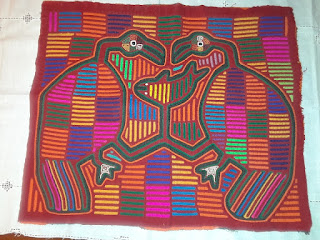Sunday, November 12, 2017
but the real reason...
... the 'thing' that captured my attention when I saw the flyer from Emory University, was the opportunity to go and see a temporary exhibit of textile arts called 'molas'. What? Molas. No, not some ingredient in Latino recipes. No food or drink allowed in the museum.
Molas are decorative fabric panels made by indigenous people of Panama, specifically those living on islands along the eastern coast, in the San Blas island chain. You probably did not even know Panama had islands, right?I am thinking that the natives did not start making the brightly colored designs until after the Conquistadors invaded their lands. You remember: bringing Christianity, deadly diseases, wiping out centuries-old cultures and languages. While searching for a new trade route to the far east.
Those 'civilized' Europeans were horrified at the lack of propriety and modesty they discovered among the natives living in the heat and humidity of equatorial lands. In time, the cloth began to be used to make beautiful intricate designs on their clothing, with the aid of technology: scissors! The process is difficult to describe, but fascinating to see. I first heard of these painstakingly produced works of fiber arts when studying art history years ago. Instantly fascinated by the beautiful designs, as well as the time-consuming effort required to imagine, plan and create the finished piece-work.
Perhaps best explained as a combination of applique and quilting. Even though difficult to envision the finished product can be breath-taking when you consider the many hours invested in layout, assembly and completion. Starting with two contrasting colors of fabric, with many smaller bits of other colors of material sandwiched in between the top and bottom, small slits are cut though the top layer to let the other smaller pieces/colors appear, with the cut/raw edges carefully folded under and hand sewn to create a finished piece. Designs can be birds, sea life, mammals, native plants, or even abstract, all inspired by and adapted from their surroundings.
I don't think these finely crafted pieces could be done without that nifty addition of sharply honed western technology: scissors used to make those slits and snip tiny holes in the material. Though it does not outweigh the loss of lives and vanished, irreplaceable cultural history that disappeared under the ravages of European domination, these amazingly intricate works would not otherwise exist. A wee small bright spot that is a result of the greed of the Spanish Queen who financed that first voyage in 1492, when Columbus sailed the ocean blue...
Subscribe to:
Post Comments (Atom)


No comments:
Post a Comment